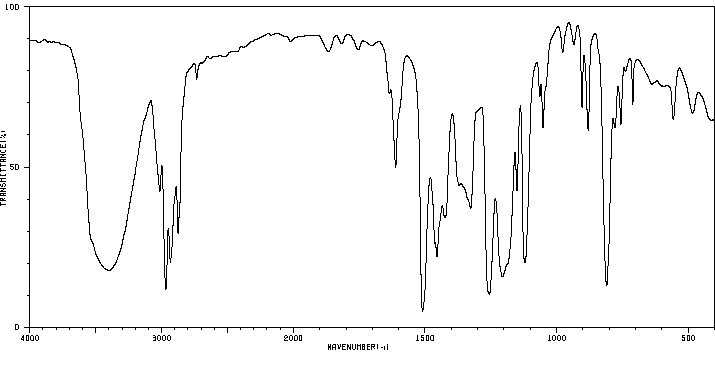2-乙基-4-甲基苯酚 | 3855-26-3
中文名称
2-乙基-4-甲基苯酚
中文别名
4-甲基-2-乙基苯酚;2-乙基对甲酚
英文名称
2-ethyl-4-methylphenol
英文别名
——
CAS
3855-26-3
化学式
C9H12O
mdl
——
分子量
136.194
InChiKey
AVVVXUXMKWPKAJ-UHFFFAOYSA-N
BEILSTEIN
——
EINECS
——
-
物化性质
-
计算性质
-
ADMET
-
安全信息
-
SDS
-
制备方法与用途
-
上下游信息
-
文献信息
-
表征谱图
-
同类化合物
-
相关功能分类
-
相关结构分类
物化性质
-
熔点:25.7°C
-
沸点:222.4°C
-
密度:0.9809 (estimate)
-
LogP:3.006 (est)
-
稳定性/保质期:
存在于烟气中。
计算性质
-
辛醇/水分配系数(LogP):2.7
-
重原子数:10
-
可旋转键数:1
-
环数:1.0
-
sp3杂化的碳原子比例:0.33
-
拓扑面积:20.2
-
氢给体数:1
-
氢受体数:1
安全信息
-
海关编码:2907199090
SDS
模块 1. 化学品
1.1 产品标识符
: 2-Ethyl-4-methylphenol
产品名称
1.2 鉴别的其他方法
无数据资料
1.3 有关的确定了的物质或混合物的用途和建议不适合的用途
仅用于研发。不作为药品、家庭或其它用途。
模块 2. 危险性概述
2.1 GHS-分类
急性毒性, 经口 (类别 4)
严重眼睛损伤 (类别 1)
2.2 GHS 标记要素,包括预防性的陈述
象形图
警示词 危险
危险申明
H302 吞咽有害。
H318 造成严重眼损伤。
警告申明
预防措施
P264 操作后彻底清洁皮肤。
P270 使用本产品时不要进食、饮水或吸烟。
P280 戴护目镜/戴面罩。
事故响应
P301 + P312 如果吞咽并觉不适: 立即呼叫解毒中心或就医。
P305 + P351 + P338 如与眼睛接触,用水缓慢温和地冲洗几分钟。如戴隐形眼镜并可方便地取
出,取出隐形眼镜,然后继续冲洗.
P310 立即呼叫中毒控制中心或医生.
P330 漱口。
废弃处置
P501 将内容物/ 容器处理到得到批准的废物处理厂。
2.3 其它危害物 - 无
模块 3. 成分/组成信息
3.1 物 质
: C9H12O
分子式
: 136.20 g/mol
分子量
组分 浓度或浓度范围
2-Ethyl-4-methylphenol
<=100%
化学文摘登记号(CAS 3855-26-3
No.)
模块 4. 急救措施
4.1 必要的急救措施描述
一般的建议
请教医生。 向到现场的医生出示此安全技术说明书。
吸入
如果吸入,请将患者移到新鲜空气处。 如呼吸停止,进行人工呼吸。 请教医生。
皮肤接触
用肥皂和大量的水冲洗。 请教医生。
眼睛接触
用大量水彻底冲洗至少15分钟并请教医生。
食入
切勿给失去知觉者通过口喂任何东西。 用水漱口。 请教医生。
4.2 主要症状和影响,急性和迟发效应
据我们所知,此化学,物理和毒性性质尚未经完整的研究。
4.3 及时的医疗处理和所需的特殊处理的说明和指示
无数据资料
模块 5. 消防措施
5.1 灭火介质
灭火方法及灭火剂
用水雾,抗乙醇泡沫,干粉或二氧化碳灭火。
5.2 源于此物质或混合物的特别的危害
碳氧化物
5.3 给消防员的建议
如必要的话,戴自给式呼吸器去救火。
5.4 进一步信息
无数据资料
模块 6. 泄露应急处理
6.1 作业人员防护措施、防护装备和应急处置程序
使用个人防护用品。 避免粉尘生成。 避免吸入蒸气、烟雾或气体。 保证充分的通风。
人员疏散到安全区域。 避免吸入粉尘。
6.2 环境保护措施
不要让产品进入下水道。
6.3 泄漏化学品的收容、清除方法及所使用的处置材料
收集和处置时不要产生粉尘。 扫掉和铲掉。 放入合适的封闭的容器中待处理。
6.4 参考其他部分
丢弃处理请参阅第13节。
模块 7. 操作处置与储存
7.1 安全操作的注意事项
避免接触皮肤和眼睛。 避免形成粉尘和气溶胶。
在有粉尘生成的地方,提供合适的排风设备。
7.2 安全储存的条件,包括任何不兼容性
贮存在阴凉处。 使容器保持密闭,储存在干燥通风处。
7.3 特定用途
无数据资料
模块 8. 接触控制和个体防护
8.1 容许浓度
最高容许浓度
没有已知的国家规定的暴露极限。
8.2 暴露控制
适当的技术控制
根据良好的工业卫生和安全规范进行操作。 休息前和工作结束时洗手。
个体防护设备
眼/面保护
面罩與安全眼鏡请使用经官方标准如NIOSH (美国) 或 EN 166(欧盟) 检测与批准的设备防护眼部。
皮肤保护
戴手套取 手套在使用前必须受检查。
请使用合适的方法脱除手套(不要接触手套外部表面),避免任何皮肤部位接触此产品.
使用后请将被污染过的手套根据相关法律法规和有效的实验室规章程序谨慎处理. 请清洗并吹干双手
所选择的保护手套必须符合EU的89/686/EEC规定和从它衍生出来的EN 376标准。
身体保护
全套防化学试剂工作服, 防护设备的类型必须根据特定工作场所中的危险物的浓度和数量来选择。
呼吸系统防护
如危险性评测显示需要使用空气净化的防毒面具,请使用全面罩式多功能微粒防毒面具N100型(US
)或P3型(EN
143)防毒面具筒作为工程控制的候补。如果防毒面具是保护的唯一方式,则使用全面罩式送风防毒
面具。 呼吸器使用经过测试并通过政府标准如NIOSH(US)或CEN(EU)的呼吸器和零件。
模块 9. 理化特性
9.1 基本的理化特性的信息
a) 外观与性状
形状: 固体
b) 气味
无数据资料
c) 气味阈值
无数据资料
d) pH值
无数据资料
e) 熔点/凝固点
无数据资料
f) 沸点、初沸点和沸程
无数据资料
g) 闪点
无数据资料
h) 蒸发速率
无数据资料
i) 易燃性(固体,气体)
无数据资料
j) 高的/低的燃烧性或爆炸性限度 无数据资料
k) 蒸气压
无数据资料
l) 蒸汽密度
无数据资料
m) 密度/相对密度
无数据资料
n) 水溶性
无数据资料
o) n-辛醇/水分配系数
辛醇--水的分配系数的对数值: 2.997
p) 自燃温度
无数据资料
q) 分解温度
无数据资料
r) 粘度
无数据资料
模块 10. 稳定性和反应活性
10.1 反应性
无数据资料
10.2 稳定性
无数据资料
10.3 危险反应
无数据资料
10.4 应避免的条件
无数据资料
10.5 不相容的物质
强氧化剂
10.6 危险的分解产物
其它分解产物 - 无数据资料
模块 11. 毒理学资料
11.1 毒理学影响的信息
急性毒性
无数据资料
皮肤刺激或腐蚀
无数据资料
眼睛刺激或腐蚀
无数据资料
呼吸道或皮肤过敏
无数据资料
生殖细胞致突变性
无数据资料
致癌性
IARC:
此产品中没有大于或等于 0。1%含量的组分被 IARC鉴别为可能的或肯定的人类致癌物。
生殖毒性
无数据资料
特异性靶器官系统毒性(一次接触)
无数据资料
特异性靶器官系统毒性(反复接触)
无数据资料
吸入危险
无数据资料
潜在的健康影响
吸入 吸入可能有害。 可能引起呼吸道刺激。
摄入 误吞对人体有害。
皮肤 通过皮肤吸收可能有害。 可能引起皮肤刺激。
眼睛 引起眼睛灼伤。
接触后的征兆和症状
据我们所知,此化学,物理和毒性性质尚未经完整的研究。
附加说明
化学物质毒性作用登记: 无数据资料
模块 12. 生态学资料
12.1 生态毒性
无数据资料
12.2 持久性和降解性
无数据资料
12.3 潜在的生物累积性
无数据资料
12.4 土壤中的迁移性
无数据资料
12.5 PBT 和 vPvB的结果评价
无数据资料
12.6 其它不良影响
无数据资料
模块 13. 废弃处置
13.1 废物处理方法
产品
将剩余的和不可回收的溶液交给有许可证的公司处理。
与易燃溶剂相溶或者相混合,在备有燃烧后处理和洗刷作用的化学焚化炉中燃烧
受污染的容器和包装
按未用产品处置。
模块 14. 运输信息
14.1 联合国危险货物编号
欧洲陆运危规: - 国际海运危规: - 国际空运危规: -
14.2 联合国运输名称
欧洲陆运危规: 非危险货物
国际海运危规: 非危险货物
国际空运危规: 非危险货物
14.3 运输危险类别
欧洲陆运危规: - 国际海运危规: - 国际空运危规: -
14.4 包裹组
欧洲陆运危规: - 国际海运危规: - 国际空运危规: -
14.5 环境危险
欧洲陆运危规: 否 国际海运危规 国际空运危规: 否
海洋污染物(是/否): 否
14.6 对使用者的特别提醒
无数据资料
模块 15 - 法规信息
N/A
模块16 - 其他信息
N/A
上下游信息
-
上游原料
中文名称 英文名称 CAS号 化学式 分子量 2-乙基-1-甲氧基-4-甲基苯 2-ethyl-4-methylphenyl methyl ether 79744-78-8 C10H14O 150.221 2-羟基-5-甲基苯乙酮 5-methyl-2-hydroxyacetophenone 1450-72-2 C9H10O2 150.177 —— 1-(4-ethyl-5-hydroxy-2-methyl-phenyl)-ethanone 858854-30-5 C11H14O2 178.231 3-乙基甲苯 1-Methyl-3-ethylbenzene 620-14-4 C9H12 120.194 -
下游产品
中文名称 英文名称 CAS号 化学式 分子量 2-乙基-1-甲氧基-4-甲基苯 2-ethyl-4-methylphenyl methyl ether 79744-78-8 C10H14O 150.221 —— 2-Ethyl-6-tert.-butyl-4-methyl-phenol 4560-36-5 C13H20O 192.301 —— 3'-ethyl-5'-methyl-2'-hydroxy-acetophenone 81591-15-3 C11H14O2 178.231 —— 1-(4-ethyl-2-hydroxy-5-methyl-phenyl)-ethanone 93351-16-7 C11H14O2 178.231 —— 1-(4-ethyl-5-hydroxy-2-methyl-phenyl)-ethanone 858854-30-5 C11H14O2 178.231
反应信息
-
作为反应物:描述:参考文献:名称:v. Auwers; Mauss, Chemische Berichte, 1928, vol. 61, p. 1502摘要:DOI:
-
作为产物:描述:参考文献:名称:Acute Reversible Cardiomyopathy and Thromboembolism After Cisplatin and 5-Fluorouracil Chemotherapy摘要:心肌病和闭塞性血栓栓塞事件在接受顺铂和5-氟尿嘧啶(5-FU)治疗后的急性发展是罕见的,但常常致命。作者报道了一名52岁患软腭鳞状细胞癌的男性成功管理此类事件的案例。可能的病理生理机制也进行了讨论。DOI:10.1177/000331970005101011
文献信息
-
HIV protease inhibiting compounds申请人:Flentge Charles A.公开号:US20110003827A1公开(公告)日:2011-01-06A compound of the formula is disclosed as an HIV protease inhibitor. Methods and compositions for inhibiting an HIV infection are also disclosed.公开了一种具有以下公式的化合物,作为HIV蛋白酶抑制剂。还公开了抑制HIV感染的方法和组合物。
-
PHOTOREACTIVE COMPOUNDS申请人:Lincker Frederic公开号:US20140192305A1公开(公告)日:2014-07-10The present invention relates to photoreactive compounds that are particularly useful in materials for the alignment of liquid crystals.本发明涉及光反应性化合物,特别适用于液晶对准材料的制作。
-
Peroxy esters—III作者:Akira Nishinaga、Koichi Nakamura、Teruo Matsuura、Anton Rieker、Dieter Koch、Rainer GriesshammerDOI:10.1016/0040-4020(79)88012-6日期:1979.1(peroxy-p-quinols) and their acetates leads to the corresponding quinoxy cations through a protonation at the peroxy group, giving rise to different types of products depending on the structure of the peroxy esters. 2,4,6-Trialkyl-p-quinoxy cations undergo a rearrangement with ring opening to give 4-oxa-2-cyclopentenone derivatives, except for p-quinoxy cations with t-butyl or benzyl groups at the 4-position对4-氢过氧-2,5-环己二酮(过氧-对-喹诺酮)及其乙酸盐进行酸处理后,会通过过氧基团上的质子化反应生成相应的喹oxy氧基阳离子,这取决于产物的结构而产生了不同类型的产物过氧酯。2,4,6-三烷基-对-喹啉阳离子进行开环重排,得到4-氧杂-2-环戊烯酮衍生物,但在4-位带有叔丁基或苄基的对-喹氧基阳离子除外,其中2,仅获得6-二叔丁基对苯醌。在4-位具有芳族取代基的对-喹啉阳离子经历该取代基向阳离子氧的迁移。在过氧的情况下p具有4-芳基取代基的-喹诺醇(甚至是过氧-对萘萘酚),质子化发生在过氧键的任一O原子上。具有不受阻碍的二烯酮体系的过氧对苯二酚及其乙酸盐对酸处理非常稳定,这可能是由于过氧和二烯酮CO基团的竞争性质子化所致。在含有氧官能团的溶剂中,反应缓慢进行。
-
Gonadotropin Releasing Hormone Receptor Antagonist, Preparation Method Thereof And Pharmaceutical Composition Comprising The Same申请人:Kim Seon Mi公开号:US20130137661A1公开(公告)日:2013-05-30Disclosed are compounds useful as gonadotrophin-releasing hormone (“GnRH”) receptor antagonist.披露了作为促性腺激素释放激素(“GnRH”)受体拮抗剂有用的化合物。
-
Examination of Selectivity in the Oxidation of <i>ortho</i> ‐ and <i>meta</i> ‐Disubstituted Benzenes by CYP102A1 (P450 Bm3) Variants作者:Samuel D. Munday、Shaghayegh Dezvarei、Ian C.‐K. Lau、Stephen G. BellDOI:10.1002/cctc.201700116日期:2017.7.7Cytochrome P450 CYP102A1 (P450 Bm3) variants were used to investigate the products arising from the P450 catalysed oxidation of a range of disubstituted benzenes. The variants used all generated increased levels of metabolites compared to the wild‐type enzyme. With ortho‐halotoluenes up to six different metabolites could be identified whereas the oxidation of 2‐methoxytoluene generated only two aromatic细胞色素P450 CYP102A1(P450 Bm3)变体用于研究由P450催化的一系列双取代苯氧化产生的产物。与野生型酶相比,使用所有变体的代谢物含量均增加。与邻可以鉴定出多达六个不同代谢产物的卤代甲苯,而2-甲氧基甲苯的氧化仅生成两种芳族氧化产物。乙基的加入显着地将氧化的选择性转移至更具反应性的苄基位置。在2-甲基苯乙烯中,烯烃的环氧化也比芳族氧化更可取。在某些P450催化的底物周转过程中,由于一个取代基迁移到苯环上的不同位置而产生了重要的次要产物。例如,由2-溴甲苯的周转形成了2-溴-6-甲基苯酚,而由2-乙基甲苯的氧化生成了脱芳香化产物6-乙基-6-甲基环己基-2,4-二烯酮。RLYF / A330P变体改变了产品分布,从而使某些代谢产物的生成量更高。使用此变体可从3-乙基甲苯中制得4-甲基-2-乙基苯酚,选择性≥90%,并且具有适合扩大反应规模的生物催化活性。
表征谱图
-
氢谱1HNMR
-
质谱MS
-
碳谱13CNMR
-
红外IR
-
拉曼Raman
-
峰位数据
-
峰位匹配
-
表征信息
同类化合物
(2-氯-6-羟基苯基)硼酸
黄柄曲菌素
高香草酸-d3
高香草酸-13C6
高香草酸
高香兰酸乙酯
高辣椒素II
高二氢辣椒素I
香草醛醛肟
香草醛苯腙
香草醛-甲氧基-13C
香草醛-(N-对甲苯基肟)
香草醛
香草酸肼
香草壬酰胺
香草基扁桃酸乙酯
香草吗啉
香草二乙胺
香兰素胺硬脂酸盐
香兰素胺硬脂酸盐
香兰素胺盐酸盐
香兰素丙二醇缩醛
香兰素13C6
香兰素-D3
香兰基乙基醚
香兰基丁醚
顺式-5-正十五碳-8'-烯基间苯二酚
顺式-1-(2-羟基-5-甲基苯基)-2-丁烯-1-酮
顺式-1-(2-羟基-4-甲氧基苯基)-2-丁烯-1-酮
顺-3-氯二氢-5-苯基呋喃-2(3H)-酮
雌二醇杂质1
降二氢辣椒碱
阿诺洛尔
阿瓦醇
阿普斯特杂质
间苯二酚双(二苯基磷酸酯)
间苯二酚-烯丙醇聚合物
间苯二酚-D6
间苯二酚
间苯三酚甲醛
间苯三酚二水合物
间苯三酚
间羟基苯乙基溴
间硝基苯酚
间甲酚紫钠盐
间甲酚与对甲酚和苯酚甲醛树脂的聚合物
间甲酚-D7
间甲酚-D3
间甲酚
间溴苯酚








